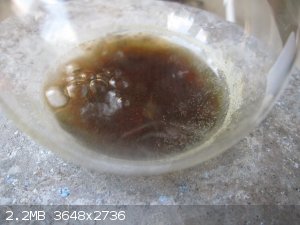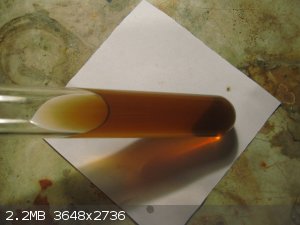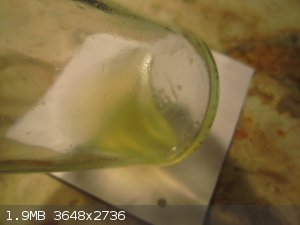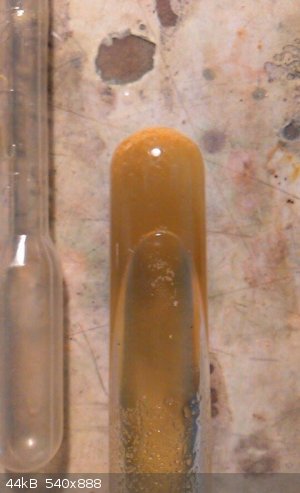
12thealchemist - 15-5-2018 at 06:02
Some time ago I prepared some Si(OEt)<sub>4</sub> via silicon sulphide and ethanol. My reasoning for this was that it would avoid having
to go via silicon tetrachloride, which a notoriously low-yielding reaction. I would, however, generate hydrogen sulphide, but on the scale I was
working, that was not difficult to deal with.
Prompted by Eddygp, I shall write up the process here.
Extraction of silicon from sand
Sand (10 g) was mixed thoroughly with magnesium powder (8 g). The mixture was piled onto a steel plate and ignited with a blowtorch. I relied on the
magnesium powder as a ignition initiator and reducing agent. When the resulting friable mass had cooled down, it was digested with hydrochloric acid
(50 mL, 31%) and allowed to react overnight. The black precipitate was filtered off, washed with water, and air-dried.
Synthesis of silicon sulphide
My first idea was to attempt union of the elements. Silicon (3 g), and sulphur (6 g) were mixed and heated to a bright red heat in a steel crucible
with a blowtorch. However, I could not achieve the temperatures required to initiate a reaction. I hypothesised that my volume was too large for the
heating method I was using. So I tried the same experiment in a test tube, but again to no avail. I researched further into the reaction, and
discovered to my chagrain that I would have to have heated the reaction mixture to about 1500°C to achieve a reaction.
My next idea was to use a method I came across in the video on silicon extraction by hkparker of youtube. He mixed sand, aluminium powder, and
sulphur. The reaction between sand and aluminium powder is too endothermic to be a viable method of obtaining silicon, but the reaction between
aluminium and sulphur is tremendously exothermic. Hence, these two reactions are combined to achieve sufficient heating for the desired reaction (6Al
+ 3SiO2 -> 2Al2O3 + Si) to take place.
So, I tried this principle. Silicon (3 g), aluminium (3 g), and sulphur (12 g) were mixed thoroughly and heated in a steel crucible (mistake). Upon
ignition of the mixture, it reached a glowing white-heat (no way of measuring temperature) and melted through the crucible with great ease. This was
allowed to cool, and the whole mixture of reaction product and crucible was put into azeotropic ethanol.
Synthesis of tetraethyl orthosilicate also known as tetraethoxysilane
The reaction mixture was allowed to sit and evolve gases outside overnight, and the following day the remains of the crucible was removed and the
mixture filtered to remove unreacted particulate. The ethanol was distilled off, leaving a high boiling residue that I considered to be my final
product. It was a rich orange-brown liquid that produced a white precipitate when a little was added to water. The resulting aqueous solution reduced
acidified dichromate.
On the basis that the liquid was high boiling and did not distil readily, and was hydrolysed by water to give a material that reduced acidified
dichromate, I concluded that I formed Si(OEt)<sub>4</sub>. I admit that there may well be Al(OEt)<sub>3</sub> contamination
also present. The red colouration I put down to Fe(OEt)<sub>3</sub>. Interestingly, over the course of the following days and weeks, this
precipitated out leaving a pale yellow liquid with the same behaviour as documented above.
High boiling residue: 
Final product: 
Reaction with water and dichromate: 
A little time later: 
Unfortunately, I do not have any pictures of the product much much later, when all the red-orange material had precipitated out.
VSEPR_VOID - 15-5-2018 at 06:56
Looks great; make sure to log it!
https://docs.google.com/document/d/1AoI2VA5L4bmFw2HwXS2OVYTV...
12thealchemist - 15-5-2018 at 07:10
I didn't know that Google Doc existed, but I have logged the relevant information, and will bear it in mind in future!
Foeskes - 15-5-2018 at 07:44
Let me guess... Aerogel?
I think you should vacuum distill it, so you can get a pure sample.
[Edited on 15-5-2018 by Foeskes]
VSEPR_VOID - 15-5-2018 at 09:47
You should post something about this in the publications section of the forum.
12thealchemist - 17-5-2018 at 08:50
Okay, I'll repeat the synthesis and get some better numbers/yields then post. At the moment, I have no idea what the yields were due to lost records
and the mess-up in melting the crucible.
fusso - 22-5-2018 at 17:29
According to wiki:
Boiling point 168 to 169 °C (334 to 336 °F; 441 to 442 K)
At elevated temperatures (>600 °C), TEOS converts to silicon dioxide:
Si(OC2H5)4 → SiO2 + 2 (C2H5)2O
The volatile coproduct is diethyl ether.
The jersey rebel - 28-5-2018 at 08:01
Looks good. There’s one thing I would say about the alternative method and that’s that it is far easier. However, I do have my doubts about the
purity. It may very well need to be distilled a couple times to get a decent yield. The silicon dioxide will also ideally need to be purified from the
getgo
Waffles SS - 11-6-2021 at 04:54
Interesting method.
No new news about result?
I want to try this method according to US2766103
No suggestion??!!
